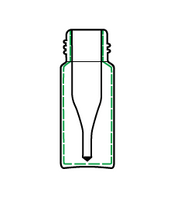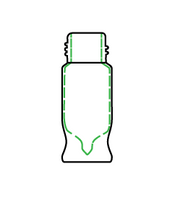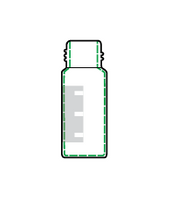
CP-0955GS-RS - EPP WO Vial/ScrwCap RSA preslit,100/pk
Chrom TechIs your data at risk due to the reactivity of your autosampler vial? Are you concerned with basic and polar analytes adsorbing to your glass vials?
Try the MicroSolv Reduced Surface Activity Glass Autosampler Vials – Now Available through Chrom Tech!
- Detect low abundance analytes normally adsorbed by your glass
- Limits pH changes in vials before injection even hours later
- Prevents sample hydrolysis that can occur in your vials—RSA glass has virtually no metals compared to MS Certified Glass Vials
- No meniscus when water is used as the main solvent
- Not coated or silanized
- Upgrade from your MS Certified Vial to the Reduced Surface Activity Vials
Who would use RSA Vials?
- Pharmaceutical Labs: Low dosage Pharma or Generics
- Environmental Labs: Low abundance analyte concentrations
- LCMS Users
- Regulated Customers
Made with a new patent pending, glass manufacturing process.
RSA Glass™ vials and inserts have reduced surface activity for basic compounds. This is due to the elimination of virtually all silanols (hydroxyl groups) that can have deleterious effects on your analytes and sample solutions.
RSA™ autosampler vials and glass inserts are not manufactured with coatings; but have significantly reduced silanols and surface ions on the glass surface normally produced during the manufacturing process. This lack of surface ions makes them an excellent choice for HPLC, LCMS, GC and GCMS applications when quantitation, reliability and accuracy are important.
With standard borosilicate glass vials and inserts sample diluents (such as water) can de-protonate the many surface hydroxyl groups; producing a negative charge on the glass wall. The “acidic” functionality of silanols has been known to cause adsorption of basic compounds, change the sample solution pH and/or hydrolyze susceptible compounds rendering them undetectable. With RSA Glass™ vials and inserts there is virtually no sample “loss to the vial” and no “pH shifting” making your analysis more reliable.
If you are working with low abundance basic samples with regular glass vials, it is very possible that some of your compounds could easily be adsorbed to the glass wall. This can change your quantitation or completely remove the compound from solution preventing injection and ultimately masking its detection and identification. With RSA Glass™ vials and inserts this will not occur if the adsorption is due to silanol interaction.
If you are working with sensitive compounds commonly found in natural products, biological samples or chemical synthesis, the glass wall could be a problem for basic compounds. With RSA™ glass vials this problem is eliminated.
If you are working with basic proteins that adsorb or are affected by silanols or normal glass siloxanes; RSA-Pro™ surface treated glass vials and inserts will be a good solution for you. If your proteins are sticking to the glass due to adsorption by the hydrophilic surface, RSA Glass™ provides an almost completely ion free and an even less adsorptive surface. The low adsorption performance of RSA-Pro™ glass & treatment over standard borosilicate silanized glass is far superior for proteins and peptides especially when comparing adsorption consistency from vial to vial, even in the same package.
RSA glass vials are batch tested for metals that may cause sample or diluent contamination. It has ULTRA low levels of sodium, calcium, aluminum and boron. Sodium and boron levels are 200 to 300 times less concentrated compared to leading manufacturers with calcium and aluminum almost non-detectable. QC testing is performed using ion selective electrode and water from the vials after a 4 hour "soak" time.
There is no significant cost increase for RSA Glass™ vials and inserts compared to "Certified" products on the market. RSA™ vials are QC tested to meet or exceed any commercially “certified” vial or insert.
| Brochures | |
|---|---|
Chrom Tech Vials & PlatesDiscover our most popular vials and 96-well plates | Download |
| Blogs | |
How to Choose the Right Vial for ChromatographyWith so many chromatography vials available, determining what vial to order can be overwhelming. We simplify the process by breaking down the options into application-specific categories. | |
Getting to the Bottom of Vial InsertsIf you're working with small sample volumes, vial inserts will be critical for reaching the final drops of sample. In this blog, we help you determine which vial inserts are appropriate for your vials. | |
- Type:
- Convenience Pack
- Unit of Measure:
- EA
- QTY:
- 100/pk
- Volume:
- 2 mL
- Color:
- Clear
- Material:
- Glass
- Closure Style:
- Screw







